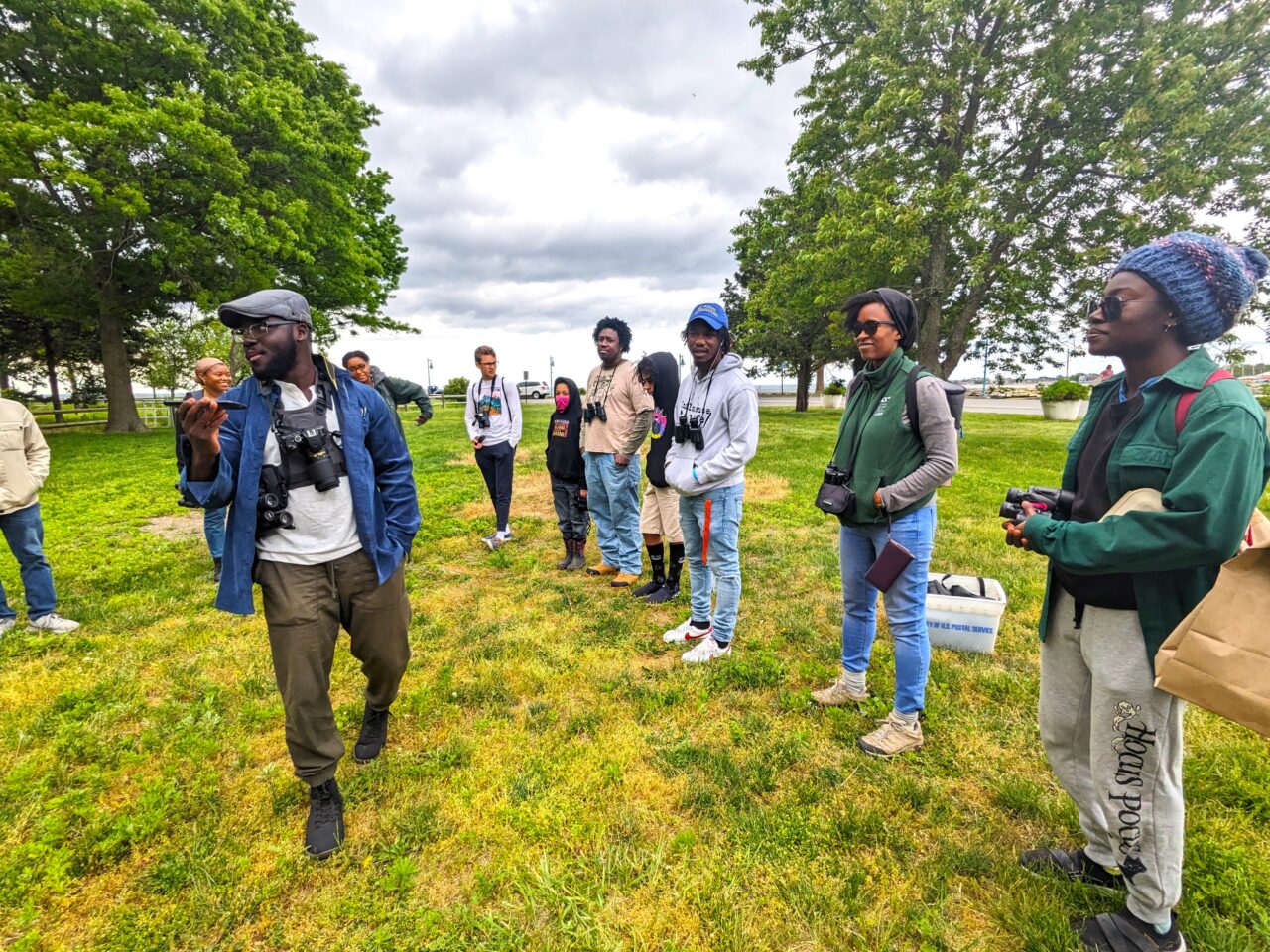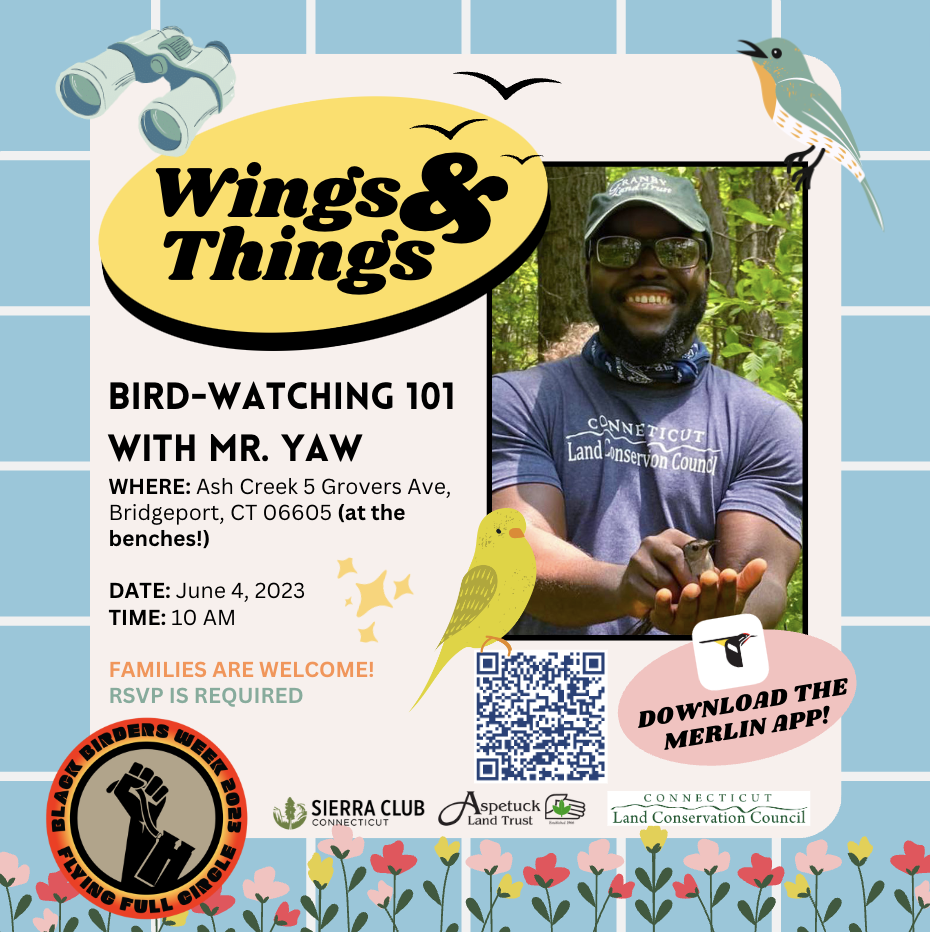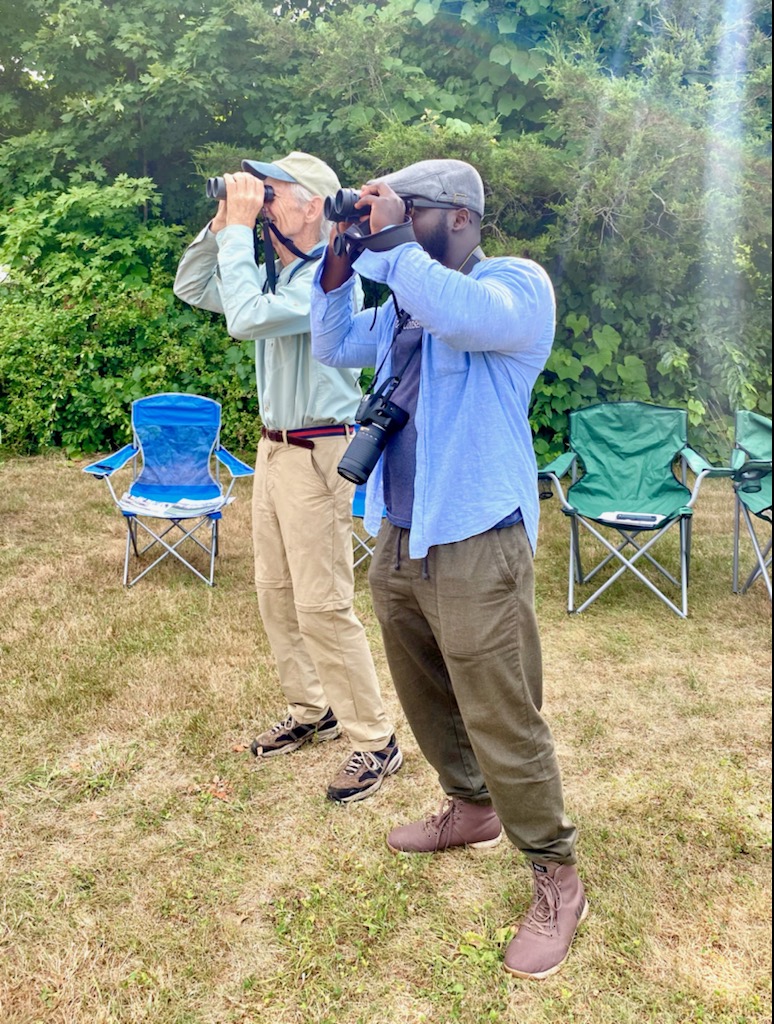Connecticut Land Conservation Council
Why Bird Conservation?
“Equity, Diversity, Inclusion, and Justice (EDIJ) work is not an add-on to the work land trusts do—it’s intrinsically part of it,” notes Yaw Owusu Darko, senior project specialist at the Connecticut Land Conservation Council (CLCC), an umbrella organization for land trusts in the state. Darko believes that EDIJ efforts are an integral component of land conservation work, and being willing to move outside of your comfort zone is necessary for making progress in this area.
Darko doesn’t just talk the talk when it comes to EDIJ—he literally walks the walk during the Bird and Hike with CT Land Trusts outings that he leads. Initial funding for this program was provided in 2022 by a $5,000 small grant from the Cornell Lab of Ornithology’s Land Trust Bird Conservation Initiative (LTBCI).
The idea for the program was conceived in 2022, when David Bingham, vice president of the board of the Salem Land Trust, reached out to Darko with an idea. Bingham had seen a picture of Darko holding a Gray Catbird at a bird banding event in a CLCC newsletter, and he was excited to learn that Darko was interested in birding. A big birder himself, Bingham saw an opportunity for Darko to help engage a more diverse audience on Salem Land Trust properties.
The grant was originally titled “Bird and Hike with Salem Land Trust,” but it evolved to become “Bird and Hike with Connecticut Land Trusts” after Darko received feedback from participants on the first hike. During the hike at Salem Land Trust with members of Outdoor Afro, participants suggested that the program might be more successful if the hikes were held at land trusts properties near urban areas. Darko consulted with Bingham, who agreed that partnering with other land trusts in Connecticut made sense. Bingham’s willingness to expand beyond the Salem Land Trust was one key to the program’s success, Darko said.
Spotlight Resources: Collaborative Partnerships, Merlin, and eBird

Darko wasn’t a big birder before this program began, so he leaned on Merlin Bird ID and eBird to familiarize himself with species he might encounter at the sites where the hikes were held. Before all the hikes, he visited the land trust properties, using the Merlin app to identify birds, then creating field guides for the events with this information. Walking the routes beforehand also allowed Darko to ensure that the trails were safe and accessible.
For people of color and members of other groups that are currently underrepresented in birding, outdoor safety and accessibility means much more than trails clear of physical hazards. Even unclear signage at outdoor sites can cause uncertainty, says Darko, leading to thoughts like “Do I belong here?”
Communicating “you belong here” was one of the goals of this program. By helping people of color feel comfortable in outdoor spaces and see themselves as stewards of the environment, Darko believes we can bring new perspectives into conservation work.
Community-centered conservation is the heart of Darko’s work at CLCC, an organization that provides financial and technical assistance to 120 land trusts in Connecticut. Each of the six Bird and Hike events were hosted by a partnership between a local land trust and a community group, and one of the strategies for creating a more welcoming environment for participants was to keep the focus on the community group. Events were planned around the preferences of community groups like Grow Hartford Youth Program, Green Village Initiative, Leadership Greater Hartford, and Black AF in STEM.
One barrier to participation in outdoor events for members of underrepresented groups can be transportation, so locations for the hikes were chosen with input from community groups. In one case, a bus provided transportation to the land trust property. Another site, a 693-acre park in Hartford, was chosen for its proximity to an urban area. Although the park is well-known in the area, many local residents were surprised to learn about its extensive trail system.
Finding and navigating trails, and knowing how not to get lost, are concerns that Darko often heard from participants on the hikes. Many participants told him that they wouldn’t have been on the hike if he wasn’t leading it—having a person of color in a position of leadership, who is a representative of the engaged community, made it easier and more relaxing for them to place themselves in that outdoor space. With someone they trusted leading the hikes, there was a clear sense of inclusivity and representation among participants, and that ease made participants more receptive to learning about what was around them.
Before each hike, Darko taught people how to use binoculars, provided an introduction to Merlin and eBird, and gave instructions for downloading the birding apps. With these tools, participants were primed for making the connection between what birds look like, the sounds they make, and where they live.
Making the Connection

Darko really enjoyed seeing people light up when they connected bird sounds with particular species. Participants often exclaimed, “I’ve heard that bird, but I didn’t know it looked like that!” when Darko played the sounds of common birds like Blue Jays. Merlin, the Cornell Lab app that can identify birds by sound, picture, or observed characteristics, was especially fascinating to many of the people on the hikes.
This connection to nature began to bridge the gap, helping participants see themselves as inhabitants, and hopefully future stewards, of the outdoors. By helping people feel that they are deserving of these experiences, of the benefits and rewards of being outdoors, these hikes served a broader goal: fostering an ethic of conservation.
During the brainstorming phase of this program, Bingham told Darko that he knew he was not going to be around forever, and he wanted his love of birding and ethic of conservation to be passed on. He said he wanted to connect more people to the land, and he realized that they might be people who looked different than him or brought a different perspective to it.
Darko hopes that the success of this program will inspire more land trusts to get out of their silos and reach beyond the people with whom they traditionally work. These hikes helped open new lines of communication between local land trusts and community organizations, bringing new dimensions and voices to the conversations. Darko points to a clear example of this happening—one participant became a junior board member of a land trust, helping to develop programming on one of the preserves.
Advice to Other Land Trusts

The willingness to listen to groups you’re working with is critical, says Darko. Being flexible and open-minded is essential for success when engaging with more diverse audiences, and that can lead to new discoveries, opportunities, and partnerships, as demonstrated by the evolution of this project.
Don’t let your own biases overshadow the goals of your work, recommends Darko. Everyone has a different perspective on conservation and one should not preclude others, he added.
Listen to feedback and make adjustments accordingly. Be willing to learn as you go, and find partners who are willing to engage in that discovery process with you. Although Darko was not a birding expert when this program began, by the last hike, he had purchased a spotting scope and was using it regularly. On a hike near an estuary of Ash Creek during Black Birders week, he saw a group of Yellow-crowned Night Herons almost a quarter of a mile away with his scope, an incredible experience that he was able to share with others on the hike because of his own willingness to learn, grow, and adapt.
Next Steps
A welcomed result of this project was the creation of a new position at CLCC; the new community conservation coordinator will increase CLCC’s capacity to connect land trusts in the state with a wider audience. With a spreadsheet of community groups to reach out to and plans for more frequent Bird and Hike events in 2024, the new staff member is working with Darko to build sustainable funding streams to support the future success of the program.
Darko is also working with the community conservation coordinator to think of novel ways to engage members of underrepresented groups in the land trust community; for example, they are considering hosting disability friendly walks in the coming year. CLCC staff members are working to expand the definition of diversity and exploring how inclusivity of other groups and issues—such as LGBTQ+, food insecurity, and socio-economic status—may help advance the organization’s broader mission of elevating and strengthening land conservation in Connecticut.


